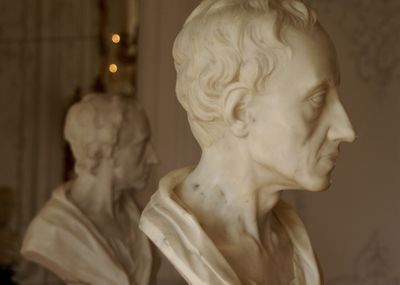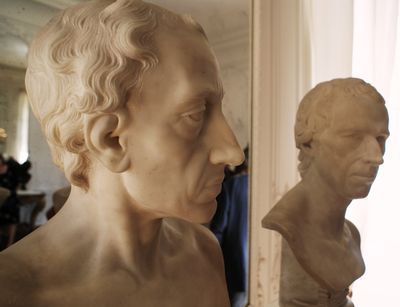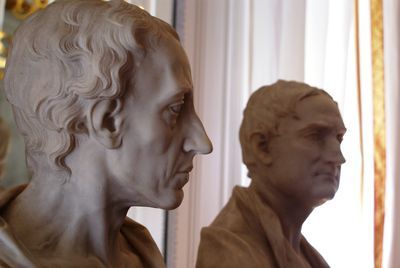Alexander Pope: A poet in marble
Photo: M. Caines
By MICHAEL CAINES
One day in March 1742, the aspiring artist Joshua Reynolds, not yet twenty years old, was attending an auction in Covent Garden, when the crowd parted and somebody both very great and very small walked in: the poet Alexander Pope.
Reynolds remembered him as being “about four feet six high; very humpbacked and deformed; he wore a black coat; and according to the fashion of that time, had on a little sword”. By that point in his life, only a couple of years before his death, Pope, a victim of Pott’s disease, would probably have been wearing a corset to support his weak, crooked spine, and he only rarely appeared in public. Perhaps the most striking thing about Pope, though, apart from his stunted height and the fact that everybody (“by a kind of enthusiastic impulse”, according to Boswell’s version of Reynolds’s anecdote) wanted to bow to him or shake his hand (depending on which source you prefer), was his face. Understandably, Reynolds, the future portrait-painter to the elite, thought it an extremely interesting one:
“[Pope] had a large and very fine eye, and a long handsome nose; his mouth had those peculiar marks which always are found in the mouths of crooked persons; and the muscles which run across the cheek were so strongly marked as to appear like small cords.”
Boswell goes characteristically further: Pope had a “pallid, studious look; not merely a sharp, keen countenance, but something grand, like Cicero’s”.
This was the same “countenance” that the sculptor Louis François Roubiliac saw, of a man who “had been much afflicted with headache”. Roubiliac claimed that he “should have known the fact from the contracted appearance of the skin between his eyebrows, though he had not been otherwise apprised of it”.
The damaged body did not prevent Pope from becoming one of the most frequently depicted of all eighteenth-century figures. He sat almost eighty times in total for dozens of artists, who flatteringly portrayed him in paintings, engravings and sculpture (while others, in caricature, were less kind). Jonathan Richardson went so far as to portray him wreathed with bay leaves in profile, as a modern literary head fit for an antique coin. The image is a fitting one for a translator of Homer and imitator of Horace:

Books on display from the Waddesdon Collection with a portrait of Alexander Pope, c 1737 by Jonathan Richardson hanging above. On loan from the National Portrait Gallery, London. Photo: © Richard Bryant/arcaidimages.com
This is in keeping with Pope's far-reaching influence on eighteenth-century culture, not only as a poet but as an authoritative, respectable artist-intellectual: an editor of Shakespeare (whose edition distinguishes typographically between good passages and bad), a cultivator of his own remarkable "grassplot" at Twickenham, a proponent of the dangerous idea of philosophical optimism ("Whatever IS, is RIGHT", according to An Essay on Man). At the same time, Pope excelled at making enemies who didn't hold back in contradicting the dignified image he was so keen to cultivate.
Yet there is more to the artistic flattery than merely the taking of one artistic side over the other. The painters Charles Jervas (with whom Pope briefly lived and studied painting) and Sir Godfrey Kneller both emphasize the poet's large eyes and slender hands rather than anything else that the sitter would obviously have found distressing – but to markedly different effects.
Over the course of the century, two interdependent tendencies in Pope portraiture emerged from a division latent in his public persona. There is the sublime visionary who wrote the Moral Essays and An Essay on Man (“What would this Man? Now upward will he soar . . .”); and there is the satirical gentleman, the scourge of folly, the man of sense and wit who produced The Dunciad and had the epigrammatic wit to engrave the collar of the puppy he gave to Frederick, Prince of Wales: “I am his Highness’ dog at Kew; / Pray tell me, sir, whose dog are you?”
Both are Pope, although perhaps today we tend to think of the wit more than the visionary. William Blake, though no great fan of Pope, could at least give the visionary some credit, and, working on a commission, portrayed him, in the words of the literary scholar Wallace Jackson, with “head tilted upward, eyes more or less looking inward, hand on the side of the head, and hair swept backward as though by a divinely caressing wind”. To one side stands a female figure whom I reckon, from the “moon-light shade” and “visionary sword”, to be the subject by Pope’s “Elegy to the Memory of an Unfortunate Lady”, with the praying Eloisa of Pope’s celebrated Eloisa to Abelard to the other. For all that Blake spoke harshly of Pope’s “Metaphysical Jargon of Rhyming”, it is tempting to look through Eloise and suspect that something proto-Blakean lurks in lines such as:
“From the false world in early youth they fled,
By thee to mountains, wilds, and deserts led.
You rais’d these hallow’d walls; the desert smil’d,
And Paradise was open’d in the Wild.”
Did it matter what visual image people had of the poet they so ardently loved or hated? (Does it matter if we can picture Jane Austen as a girl or Jane Austen posing with the tools of her trade? Or to see what Jacob Epstein saw in his literary contemporaries?) Clearly, one of the crucial figures in the long-term evolution of the image of the poet was Roubiliac, and, as mentioned already, his image of Pope was an image taken from life.
The sculptor had taken a good, long look at Pope in a professional capacity, as he set about producing a series of striking portrait busts of the poet around the time of that Covent Garden auction. Pope sat for him in 1738, and Roubiliac produced at least four busts over the next three years, probably for Pope’s friends – all are inscribed ad vivum (ie, “from the life”, a reassuring formulation more usually seen on portrait engravings). More were to appear after Pope’s death in 1744 (or at least to remain in the sculptor’s studio until they found a buyer, as he seems to have kept a variety of his works on display as a kind of portfolio in marble; Roubiliac himself died in 1762), and variants on Roubiliac’s theme were to become commonplace.
Angelica Kauffmann, for example, as Pat Rogers notes in The Alexander Pope Encyclopedia, seems to have had Roubiliac in mind when she designed “The Muses Crowning the Bust of Pope”. A plinth raises the poet so high that the muse brandishing the laurel wreath has to both find a foothold on the plinth’s base and raise her arms above her head – while turning her head adoringly to where a second muse kneels, poring over the collected works.
That question of height is a significant one in relation to Roubiliac’s portrait busts as well as depictions of Pope in general. A few years ago, at the Huntington Library, I heard Professor Malcolm Baker of the University of California, Riverside arguing that Roubiliac used the portrait bust to engage the viewer more intimately than did his classical predecessors – Roubiliac’s, that is, were not heads to be elevated far above our own, at the level of, say, the tops of the library shelves, but to be seen close up, contemplated in the context of a modern sense of selfhood.
A few days ago, in the company of the press and various sculpted Popes in marble, terracotta and plaster, I had the pleasure of meeting Professor Baker again. The venue was at Waddesdon Manor, near Aylesbury, during the press view for a remarkable exhibition he has curated, Fame and Friendship: Pope, Roubiliac and the portrait bust. Putting it together has clearly been, if nothing else, quite a feat of loan logistics. The eminent W. K. Wimsatt managed to bring together six of Roubiliac’s busts for an exhibition in 1961; as Baker gleefully pointed out, Fame and Friendship manages two more.
Fame and Friendship comes to Waddesdon after three months at the Yale Center for British Art, and has gained what Professor Baker calls a “French tweak” (casting a sidelight on Pope’s reputation in France) and lost a little of its American lilt (a Yale-centric emphasis on Wimsatt’s contribution the study of the Pope and eighteenth-century literature).
Otherwise, this collaboration between the two institutions differs primarily in now occupying an exhibition space with its own distinctive history, and one which has some fresh relevance to Pope’s own relationships with the rich and powerful. Imagine him and Roubiliac transported to the end of the nineteenth century: would they have been the kind of artists to be patronized by Baron Ferdinand de Rothschild, who built Waddesdon both to “display his outstanding collection of art and entertain the fashionable world”, as the visitor’s guide puts it? Or (and?) would Pope have gone away and composed a “Letter to Bethmann”, full of sniggering disdain for what he had seen there?
Transport Pope a century forwards again, to the present day: if he’d got past the current Waddesdon exhibitions of eighteenth-century court ceremonies and the intriguing Lod mosaic (in which giant fish threaten merchant ships and tigers mix with giraffes and elephants but the customary, tell-tale deities and signs of human life, the ships aside, are entirely absent), he would have found, upstairs in the faux-coco château itself, himself. Two rooms of himself, in fact, and mostly in the image that he liked to project.
In the first room, the elegant visions of Jervas and Kneller hang next to Jean Baptiste Van Loo’s larger portrait of the poet as a man either nursing one of those headaches noted by Roubiliac or embroiled in a visionary composition – his elbow again rests on Homer, and the fingers are again pressed to one temple, while the other clutches a manuscript.
Pope liked Jervas’s straight-backed “man of sense” (Wallace Jackson again) enough to use as the basis for the frontispiece engraving to his Works of 1717. Unlike this full-wigged, publicly presentable young gentleman, Kneller’s Pope has a more melancholy air, reflecting the circumstances of the commission – the death of an aristocratic friend and patron – and wears a distant, distracted look. One absent-minded elbow rests on a thick volume that happens to be labelled “HOMER”. The label is the same vivid vermillion as the poet’s headgear, colour-coding the precious classical connection for us. It’s the epitome, for the time, of a man with his mind on higher things.
Opposite is Roubiliac posing with his model of a full-length stature of Shakespeare, while beneath the canvasses are display cases of books, manuscripts and other items that generally prepare you for the purely sculpted experience of the portrait busts in the second room.
Stepping from the red ante room to the white drawing room ought to feel like joining the party at last: here are the guests of honour, albeit all of them turned to stone, and several of them being the same person. We are invited nonetheless to get closer to them, to pay close attention to them as they lean forward, gaze on the crowd, bend to attend to what little gossip we have to relay – or seem to look past us, on to another world. We can see those “small cords” Reynolds noted in Pope’s cheeks, the furrowed brow, even the wrinkles.
And if you’re in the eavesdropping mood, there is conversation of a sort to be heard, too. In one corner, Pope and Laurence Sterne (as sculpted by Joseph Nollekens, c. 1770) discuss literary fame and maybe the tribulations of the literary marketplace:
Photo: M. Caines
In another, Pope and his exalted Isaac Newton fail to catch one another’s eye:
Photo: M. Caines
And commanding the centre of the room are a number of Popes placed at a muse-friendly height, all of them Roubiliac’s, and each with its own slightly different mood. That owned by David Garrick, for instance, has fuller lips and less of a twist to the neck than most of others, and appears more stubbornly Roman, perhaps because the eyes are not incised, as the majority are. Another marble bust of 1741 has more of a twist to the neck and more of an upward glance, its attention caught by some overheard piece of folly that will later make its way into the Dunciad.
Taken together, they seem to vindicate Malcolm Baker's sense of an inwardness on display in Roubiliac's work – a vision of Pope as visionary, looking off into his realm of verse, both perceiving and creating order where, to others, there might appear to be none. No wonder Michael Rysbrack’s more foppish, Jervas-lite Pope of 1730, condemned here to the status of a baroque wallflower, looks uncomfortably like he might have crashed the wrong party.
In general, the panels accompanying these exhibits offer strikingly little in the way of quotation from Pope’s poetry – is it taken for granted that every visitor will know why anybody should have cared about him at all? Or perhaps the couplets would have distracted us from the crucial relationship between the poet and the sculptor. . . . It’s interesting to learn here, though, that the intensity of Roubiliac's terracotta model of Pope's head caught the eye of Elizabeth Barrett Browning who, although it doesn’t say so in the exhibition catalogue when it quotes her, would have known something of how it felt to be “drawn with disease and bitter thoughts”; she found the bust “a too expressive, miserable face . . . and very painful, I felt, to look at”.
The dissenting voice of Pope’s enemies can barely creep among this distinguished company, but it is certainly there in Charles-Germain de Saint-Aubin’s watercolour and pencil send-up of the poet as a Peeping Tom in his subversive Livre de Caricatures tant Bonnes que mauvaises. London produced plenty of sordid and explicit etchings against Pope, such as those inspired by a story vengefully put about by Colley Cibber after Pope had made him the Arch-Dunce of the Dunciad, with titles such as “The Poetical Tom-Titt perch’d upon the Mount of Love” – but it has been prudently decided to leave such dubious pleasures for another occasion.
The portrait bust is, after all, a much weightier genre; the exhibition’s title, Fame and Friendship, points to its double significance for Pope’s reputation then and now. Rysbrack and Roubiliac alike were commissioned to provide busts for the homes of Pope’s friends or affluent admirers such as Garrick. These private emblems of friendship would also serve, however, as the basis for all kinds of public imitations – prints, engravings, enamelled Staffordshire earthenware. They represent both a web of close allegiances with loyal friends and the way Pope intended his image to stake its own powerful claim to fame.
Peter Stothard's Blog
- Peter Stothard's profile
- 30 followers






